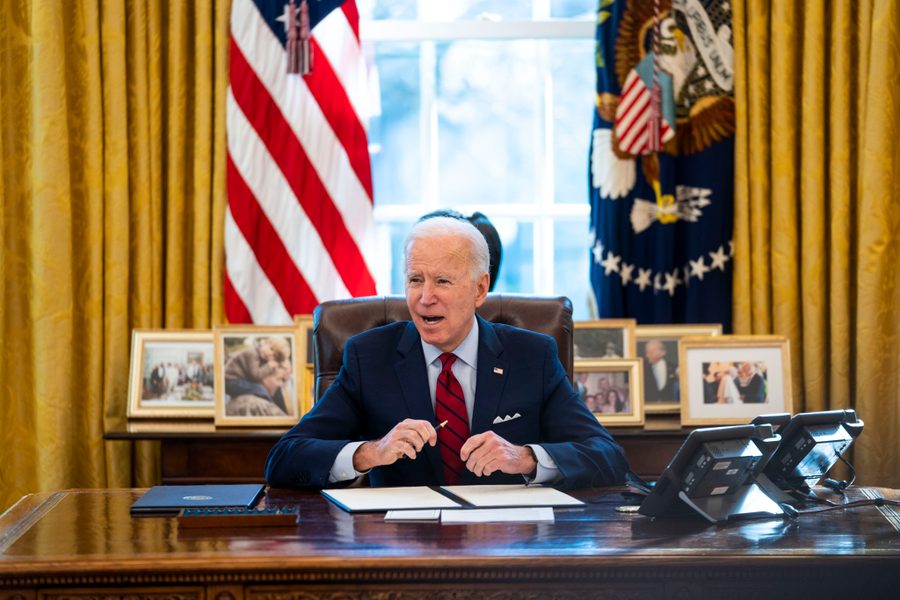Privatization Would Doom Biden's Infrastructure Plan
To meet his goals on equity, jobs and climate, President Biden should push a massive, publicly-funded infrastructure plan.
Jeremy Mohler

Within hours of becoming president, Joe Biden signed an executive order declaring that “equity for all — including people of color and others who have been historically underserved and marginalized…is the responsibility of the whole of our government.”
This order is set to apply to a broad range of policies, but one critical yet overlooked area is infrastructure. Indeed, the running of America’s water systems, highways, school buildings, transit, broadband and other public works is tightly linked to the issue of racial justice.
And for Biden to deliver, he must pursue massive, direct federal investment in infrastructure. If the administration instead proposes using a relatively small amount of federal funds and tax incentives to merely “leverage” private investment from Wall Street banks and multinational corporations — something former President Donald Trump attempted to do — the country will yet again fail to dismantle a critical structure of systemic racism.
Despite campaigning on a $2 trillion infrastructure package, the administration recently declined to name a price tag, and details remain murky. Fortunately, Peter DeFazio (D-Ore.), chair of the House Transportation and Infrastructure Committee, isn’t a fan of so-called “public-private partnerships” in infrastructure, which often amount to de facto privatization. After a recent meeting with Biden, DeFazio said, “We’re going to deal with climate change and create a hell of a lot of jobs.”
Economically, massive public spending is a no brainer — especially in the pandemic economy. Studies consistently show that federal infrastructure investment provides a shot in the arm to the economy. Investment in public transit, for example, offers a 5 to 1 economic return through new jobs, less congestion and increased productivity. Even Larry Summers, a noted centrist economist, and Ben Bernanke, former federal reserve chair under George W. Bush, have called for big spending on infrastructure.
Unfortunately, the United States has a long history of pinching federal pennies. From slavery to Jim Crow and through the post-civil rights era, right-wing politicians and business leaders have derided well-funded, democratic public institutions and services as “big government” and “federal overreach.” Racism has always been central to this project — as evinced by conservative dog whistles blasting government spending on “welfare queens” and “illegal aliens.”
As University of California, Berkeley law professor Ian Haney Lopez argues, political and economic elites exploit fear of people of color, immigrants, Muslims and others to “hijack government for their own benefit.” In other words, conservative critiques aren’t actually about the size of the government — they’re about who it serves. The 2017 Trump tax cuts, for example, overwhelmingly helped the richest Americans and blew a $450 billion hole in the federal budget. Since 1980, spending on state and local prisons has increased at triple the rate compared to public education. Yet these forms of government spending have not been met with ire by the Right.
When it comes to infrastructure, racism masked as fiscal austerity goes all the way back to the Reconstruction era. The end of the Civil War brought a wave of new construction to the South, including hospitals, housing and the region’s first public schools. As the Brookings Institution’s Vanessa Williamson has documented, wealthy Southern whites “focused their critique of Reconstruction on rising government debt and excessive spending, painting government by black people and poor whites as intrinsically corrupt.” They branded themselves as concerned “taxpayers,” allowing them to convince small farmers to join their side while avoiding explicit opposition to Black male suffrage. Ultimately, they were successful.
“After the Reconstruction governments fell, a new fiscal state served to reinforce white supremacy and strengthen antidemocratic institutions,” Williamson writes. “Under the guise of protecting the taxpayer, the white supremacist Redeemer governments slashed public budgets and shifted taxes onto the poor.”
Austerity ruled the day until the 1930s, when President Franklin D. Roosevelt’s New Deal government responded to financial crises and a powerful labor movement by creating an unprecedented number of public programs. The Works Progress Administration (WPA) employed nearly 8.5 million Americans to build post offices, bridges, schools, highways and other infrastructure.
Still, racism played a feature role. While the Roosevelt administration tripled the number of African American federal workers, it did not end the injustices that Black people suffered daily. In some cases, it even worsened Jim Crow segregation. For example, the 1935 National Labor Relations Act excluded domestic and agricultural workers, at a time when 90 percent of Black women and over half of Black men worked in either the domestic or agricultural sectors.
In the following decades, state and local leaders used federal funds for the creation of the interstate highway system — and to bulldoze “blighted” neighborhoods that were predominately communities of color. Today, highways still serve as dividing lines between Black and white sections of cities like Atlanta, Buffalo and St. Louis.
Once the civil rights movement won battles over desegregation, many white Americans withdrew their backing of well-funded public institutions and services. As mass support waned, political elites began using privatization alongside austerity in an effort to subvert multiracial democracy. Privatization allowed conservatives to attack still-popular public services like trash pick-up without seeming as though they were proposing service cuts. Meanwhile, a growing industry of corporations and other private entities began to lobby to divert public funds through the practice of contracting. Dwindling white support for public education, for example, empowered segregationist leaders to cut and divert public resources to private ends. From 1954 to 1965, southern state legislatures enacted hundreds of laws aimed at avoiding public school integration, including redirecting tax dollars to benefit private schools.
The renewed wave of anti-government sentiment was exemplified by California’s passage of Prop 13 in 1978, which reduced property taxes. As economist William Fischel has argued, Prop 13 was more than a “tax revolt,” as it’s often described. It was also a white backlash against the idea of equalizing public education funding with the state’s Black and Brown communities.
In the 1980s, President Ronald Reagan put the anti-democratic mix of austerity and privatization on the national stage. His 1987 budget proposed selling off public infrastructure, including two airports, a railroad, four regional power agencies and their electricity-generating dams and weather satellites. Throughout his presidency, Reagan used dog whistles to whip up support for cutting taxes and privatizing public goods. Good were the taxpayers who “work” for the government. Bad were the welfare queens who made “tax-free cash income.”
But Reagan was just the loudest voice in a growing chorus of anti-government rhetoric. Over time, the message moved from conservative politicians, right-wing think tanks and corporate leaders into an echo chamber of pundits and media outlets. Polemics against “big government” and “illegals” have become par for the course on right-wing social media and Fox News, the country’s most watched cable network.
To be sure, many Democrats have embraced austerity and privatization as well. The right-wing Heritage Foundation’s Ronald Utt (who was Reagan’s “privatization czar”) praised Bill Clinton in 1997 for pursuing “the boldest privatization agenda put forth by any American president to date.”
Decades of tax cuts have shrunk infrastructure spending at all levels of government. As roads, transit, schools and water systems break down, a growing industry of private equity investors, construction giants, and global water companies have sprung up, selling public-private partnerships — i.e. private financing — as a silver bullet. Everything from toll roads to university dorms have been financed with expensive private capital, often increasing costs for the public and handing over control to faraway investors.
Poor and working people, particularly those of color, have shouldered the worst outcomes of these trends. Take Flint, Michigan, a majority Black city where at least 12 people died and countless others were harmed by a lead crisis caused by old pipes and cost-cutting measures. Privatizing water systems and other infrastructure, including internet services, often has a disproportionate impact on communities of color.
The pandemic has created a generational opportunity to rebuild America — and do it right. As K. Sabeel Rahman, former Demos president who joined the Biden administration, recently argued, “We need to ensure that [new infrastructure projects] are, in fact, public. That means subjecting them to stringent regulations ensuring quality, nondiscrimination, fair pricing, and equitable access. It might mean outright public provision — either through a public option as in the health-care debate, or through outright nationalization or municipalization.”
Yet there’s reason to worry. Republicans, expectedly, are firing off warning shots, including on the issue of stimulus. “We’ll be getting senators on the record about whether taxpayers should fund checks for illegal immigrants,” said Senate Republican Leader Mitch McConnell about Biden’s pandemic relief package, turning to a longtime complaint of conservatives over government spending. “Our amendment would ensure that people who break our immigration laws aren’t receiving taxpayer-funded handouts,” said Sen. Todd Young, (R-Ind).
It’s also worrying that some Democrats are pushing for means-testing the next round of relief through age-old arguments for austerity. The Senate recently overwhelmingly voted for an amendment proposed by Sen. Joe Manchin (D-W.V.), that would block “upper-income taxpayers” from receiving stimulus checks, despite the fact that the government is using pre-pandemic 2019 tax information to determine eligibility.
“The rhetoric of the taxpayer is readymade to call into question the right of black and poor Americans to participate in or benefit from their government,” writes Williamson. “Talking about taxes allow[s] voters to put a dollar figure on their resentments, and to experience the poverty of others as persecution.”
Biden must go big on direct federal spending on infrastructure, not just to rebuild America, but to finally make meaningful, lasting progress on both economic and racial justice.







